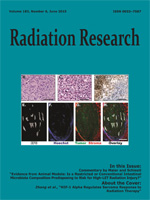Intestinal microbiota affect cell responses to ionizing radiation at the molecular level and can be linked to the development of the immune system, controlled cell death or apoptosis. We have developed a microbiota mouse model and report here that high-linear energy transfer (LET) radiation induced the repair of chromosomal DNA lesions more efficiently in conventional than in restricted intestinal microbiota mice. Based on different phylotype densities after whole-body irradiation, bacterial indicator phylotypes were found to be more abundant in restricted in microbiota than in conventional microbiota. Genotoxic phenotypes of irradiated restricted and conventional microbiota mice were compared with ataxia telangiectasia-deficient restricted and conventional microbiota mice, respectively. Those indicator phylotypes, including Bacteroides (Gram-negative bacterium cTPY-13), Barnesiella intestinihominis and others, which were identified in nonirradiated restricted microbiota mice, increase in radiation-exposed conventional microbiota along with a reduction of persistent DNA double-strand breaks in blood lymphocytes. The dynamic change of phylotype abundances elucidated a feedback mechanism and effect of intestinal microbiota composition on the adaptive response to high-LET radiation. Several other bacterial phylotypes (Helicobacter hepaticus, Helicobacter spp and others) were found to be more abundant in conventional than restricted microbiota. In this commentary, mouse models used in cancer research and radiotherapy for the study on the effects of intestinal microbiota composition on normal tissue radiation response are characterized and discussed. Highlights of this commentary: 1. Restricted microbiota phylotypes were correlated with persistent DNA double-strand breaks (DSBs) and were found to orchestrate onco-protective controlled cell death after radiation; 2. Restricted microbiota composition reduced proinflammatory extracellular-stimulated immune responses, but specifically increased anti-neoplastic cytolytic memory CD8 T cells by low taxonomic diversity and 3. DNA damage repair efficiency induced by a model of conventional microbiota most likely initiates an adaptive response to radiation through microbiota-induced intestinal sub-symptomatic inflammation.
How to translate text using browser tools
26 May 2015
Evidence from Animal Models: Is a Restricted or Conventional Intestinal Microbiota Composition Predisposing to Risk for High-LET Radiation Injury?
Irene Maier,
Robert H. Schiestl
ACCESS THE FULL ARTICLE

Radiation Research
Vol. 183 • No. 6
June 2015
Vol. 183 • No. 6
June 2015




